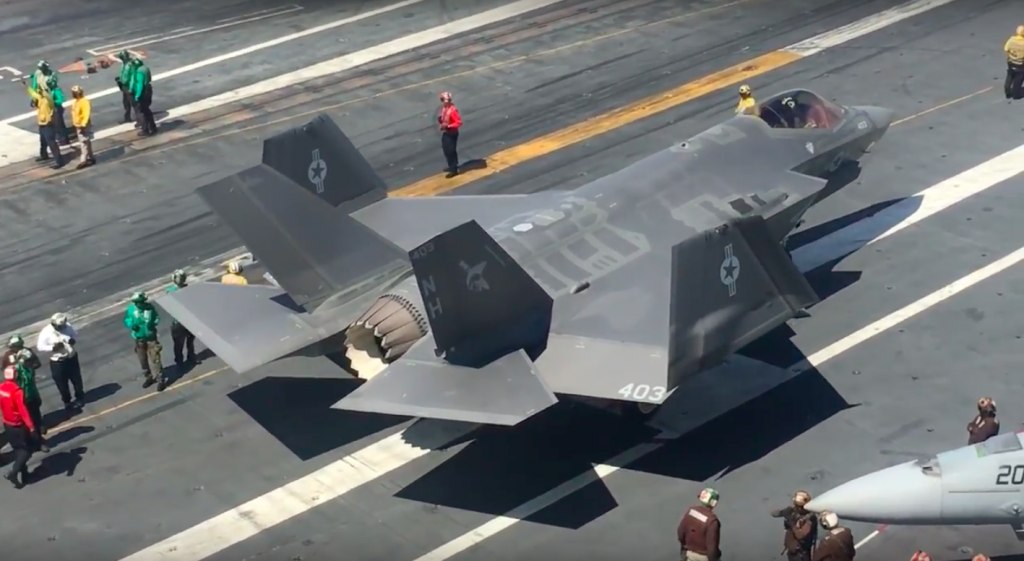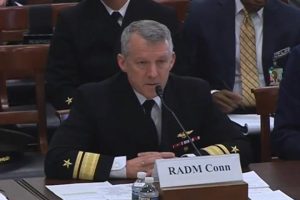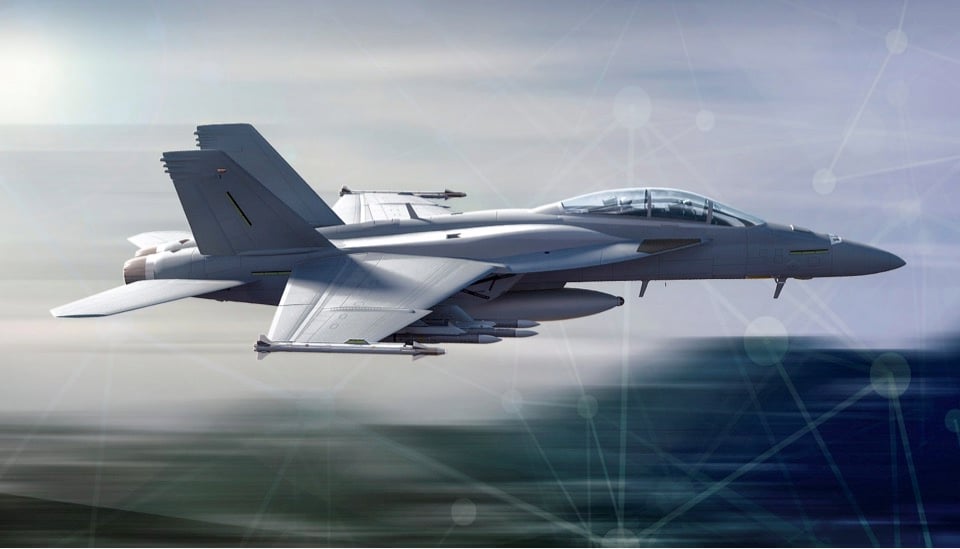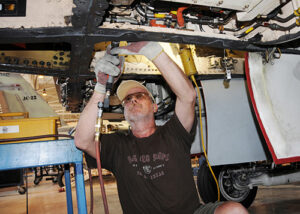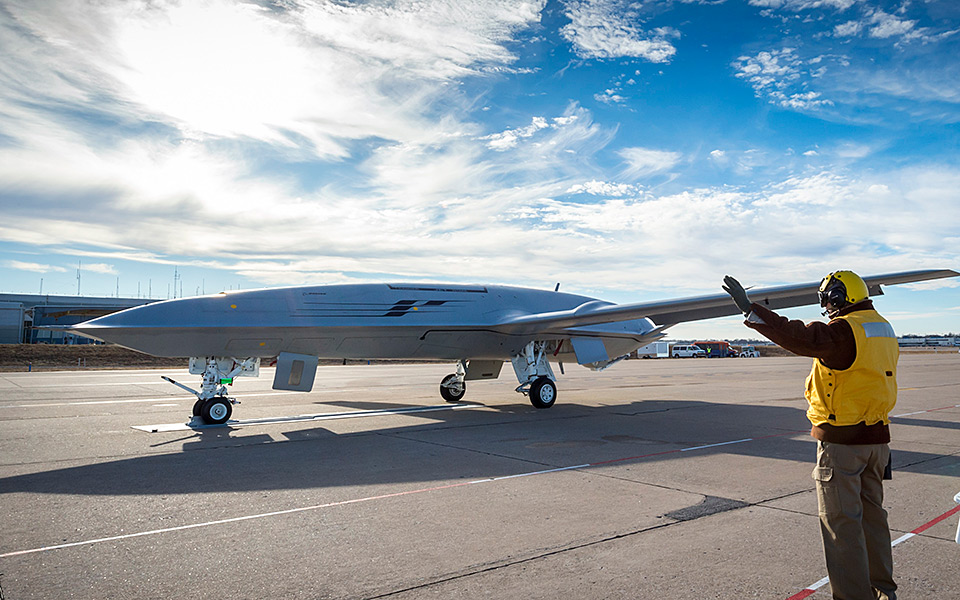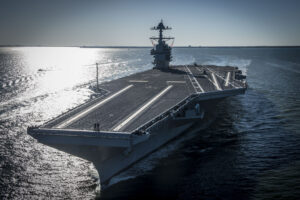F-35C Readiness Rises, Navy Fighter Shortfall Fades
Posted on
CAPITOL HILL: Naval aviation is on the mend as readiness rises and fleet age falls, officials told Congress today. Not even yesterday’s F-35 crash off the coast of Japan seemed to shake the confidence of acquisition chief James “Hondo” Geurts. His sanguinity contrasts starkly with bitter public complaints from Air Force leadership on F-35 readiness rates and its automated maintenance system, ALIS.
On Navy and Marine Corps F-35s, “we are seeing readiness rates increase, commensurate to what we’re seeing on other aviation platforms,” Geurts told reporters after an upbeat hearing with the Senate seapower subcommittee. “Our mission readiness rates when deployed … have been very good.”
Specifically for the Navy’s first squadron of carrier-based F-35Cs, VFA-147 (the Argonauts), “we’ve seen anywhere from 60 percent MC [mission capable] to 80 percent MC, depending on the day,” testified Rear Adm. Scott Conn, director of Air Warfare (OPNAV N98) on the Navy’s Pentagon staff. Now, that’s with just seven airplanes, Conn cautioned, which means one plane doing unusually well or poorly can have an outsize impact on the overall figure.
For comparison, the overall F-35 fleet, most of it Air Force, is hovering around 60 percent availability (not exactly the same measuring as Mission Capable). But F-35s at the Red Flag wargames were able to hit 90 percent. So getting a specific high-priority unit to high readiness is not the problem: It’s scaling up such small-scale successes to the fleet as a whole — even as that fleet is growing.
“We know the aircraft can be reliable and can be maintained, and maintained in an austere environment,” Geurts told reporters. “We’ve just got to be able to continue to do that at scale across the entire fleet as the fleet grows.”
So, I asked, are these just the kind of teething troubles typical for any new aircraft? It’s more complicated than that, Geurts said, because of the sheer scale and complexity of the F-35 program.
“The unique challenge to F-35 is [we’re] ramping up very quickly in production,” Geurts said. With three US services and 11 foreign partners — no longer counting Turkey — “the good news is demand is high for the aircraft and folks are flying the aircraft with lots of hours,” he went on. “The challenge for the enterprise is to be able grow production rates and be able to sustain the growing fleet, simultaneously.” That requires growing the supply system to match, he said, as well as “making some adjustments to ALIS.”
Compare those comments with Air Force Secretary Heather Wilson’s publicly savaging the Autonomic Logistics Information System as “so frustrating to use, maintainers said they were wasting 10-15 hours a week fighting with it … and looking for ways to bypass it to try to make F-35s mission capable.”
Why’s the Navy so much calmer about these problems? In part, because they haven’t bet the farm on F-35. The Air Force basically stopped buying fighters in the 1990s to wait for so-called fifth generation aircraft that, unlike the “wobblin’ goblin” F-117, combined stealth with high performance: first the F-22, cut from 381 planes to 179, and then the F-35A, of which the Air Force plans to buy 1,763. The Marines, similarly, decided to keep their old AV-8 Harriers and F-18 Hornets until the F-35B jump jet model came along. But the Navy developed a new non-stealthy aircraft, a radically upgraded F-18 known as the Super Hornet, and they’ve kept buying new ones ever since.
With the Pentagon now forcing the Air Force to buy an upgraded version of the non-stealthy F-15 Eagle, the Navy’s looking pretty smart.
F-18: Readiness, Numbers Improve
Just two years ago, 62 percent of Navy and Marine Corps fighters — Hornets and Super Hornets — were unfit to fly, and the total number in service was falling short of what war plans required. Today, Rear Adm. Conn told senators, “we’re finally … producing more aircraft than we’re burning up every year.”
As of January, 257 of roughly 400 Super Hornets were mission capable, Conn said; “last week, we had a high” — not necessarily a sustainable one — “of 304.” That’s still slightly short of former Defense Secretary Jim Mattis’s goal of bringing fighter forces to 80 percent mission capable, which for Super Hornets specifically, he said, would be 320 aircraft.
The Navy is also upgrading some of its Super Hornets, the Block II models, to a new Block III standard with higher tech and longer service life. Older Block I aircraft will be retired.
Conn didn’t offer figures for the “legacy” Hornets, which are certainly in worse shape than the Super models. (The F-18A, B, C, and D Hornets are older, smaller, and less capable than the E and F Super Hornets). But he did reemphasize that the Navy will get rid of all its F-18A/B/C/D Hornets by 2024, with the best-off aircraft going to the Marines and the worst to the scrapyard.
Improving readiness isn’t just about building new aircraft faster, Conn told Congress: It’s also about streamlining maintenance to get old, busted aircraft back in the air ASAP. In January, he said, the Navy started bringing in experts from the private sector and the other services to consult on best practices. “We’ve been able to reduce our planned maintenance intervals [i.e. turnaround time] on Super Hornets from 120 days to 60” — yes, that’s a 50 percent reduction — “and the quality of the product is better,” Conn said. The 2020 budget includes a $42.5 million request for new capital equipment such as multi-axis milling machines with robotic arms that move around the part under repair, rather than having human workers laboriously reposition it.
All these efforts add up to more aircraft ready for combat. The Navy strike fighter shortfall, Conn said, “at our lowest point is about a 51-aircraft deficit in FY [fiscal year] ’20, and that decreases to single digits by FY ’24.”
The Future: Drones & Carriers
Even as it upgrades its manned aircraft, the Navy is adding drones to the carrier air wing, starting with the MQ-25 Stingray recon/refueling UAV. (Many critics had hoped the program would build a stealthy unmanned bomber instead, but the Navy didn’t feel ready). The Navy’s vision for a high-intensity war against Russia or China is that drones — both carrier– and land-based — do the long-range scouting; as the fleet closes for battle, E-2D Hawkeyes spot the enemy on radar while EA-18G Growlers (a Super Hornet variant) jam enemy radar; and the stealthy F-35s scout deep into hostile airspace, then relay targets back to missile-laden Super Hornets.
It’ll take the Navy until 2030 to get to a 50-50 mix of fourth-generation jet fighters — F-18s — and fifth generation — F-35s. But what comes next will not be a sixth generation jet. “‘Sixth gen’ never comes out of my mouth,” Conn rebuked me when I used the term after the hearing. Instead, it’s the Next Generation Air Dominance program, which rather than a single aircraft is a holistic “system of systems,” manned and unmanned, “looking across the entire air wing,” the admiral explained. “Automation, manned-unmanned teaming, and artificial intelligence, that’s going to be maybe allow us — maybe – to go from an evolutionary approach to a revolutionary approach.”
Of course, any revolutionary new aircraft will still be flying off nuclear-powered aircraft carriers, which have been in service since the USS Enterprise was commissioned in 1961. (“Big E” served 61 years and was only decommissioned in 2012). Arguably the most controversial call in the 2020 budget plan was to retire the Nimitz-class carrier USS Truman decades early and invest the savings in “Navy 2.0” systems deemed better suited to a high-tech war with China, such as robot warships and long-range missiles. But that still leaves at least 10 carriers in the fleet for the foreseeable future.
“The Truman is a quite capable aircraft carrier, survivable, and carriers will be part of any future navy as we see it,” Geurts told senators skeptical of the decommissioning decision. (Even Navy Secretary Richard Spencer has said he’ll keep the carrier if Congress gives him the money). “But it [Truman] does have some limitations and it doesn’t have the growth potential that the [new] Ford-class gives us… We consciously took some risk to enable us to move towards the 2.0.”
Subscribe to our newsletter
Promotions, new products and sales. Directly to your inbox.

